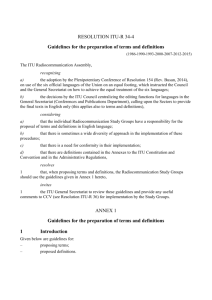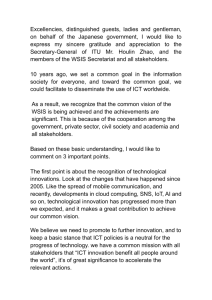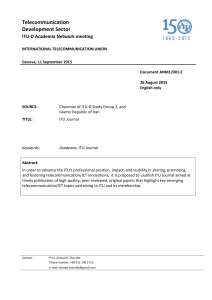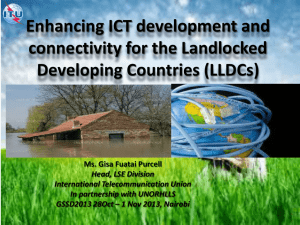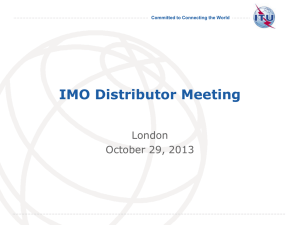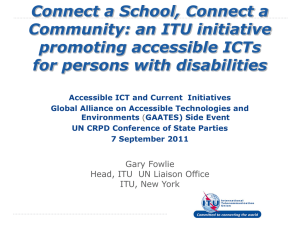PP-14 Analysis Matrix
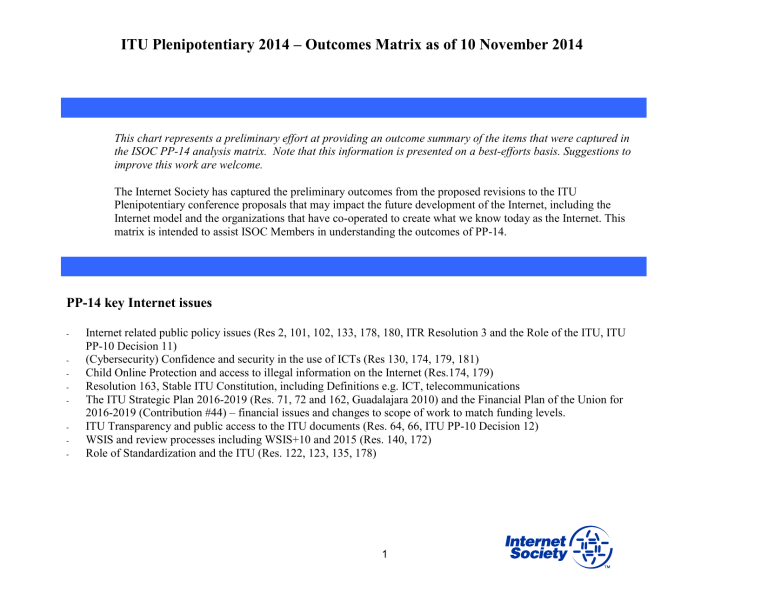
ITU Plenipotentiary 2014 – Outcomes Matrix as of 10 November 2014
This chart represents a preliminary effort at providing an outcome summary of the items that were captured in the ISOC PP-14 analysis matrix. Note that this information is presented on a best-efforts basis. Suggestions to improve this work are welcome.
The Internet Society has captured the preliminary outcomes from the proposed revisions to the ITU
Plenipotentiary conference proposals that may impact the future development of the Internet, including the
Internet model and the organizations that have co-operated to create what we know today as the Internet. This matrix is intended to assist ISOC Members in understanding the outcomes of PP-14.
-
-
-
-
-
-
-
-
PP-14 key Internet issues
Internet related public policy issues (Res 2, 101, 102, 133, 178, 180, ITR Resolution 3 and the Role of the ITU, ITU
PP-10 Decision 11)
(Cybersecurity) Confidence and security in the use of ICTs (Res 130, 174, 179, 181)
Child Online Protection and access to illegal information on the Internet (Res.174, 179)
Resolution 163, Stable ITU Constitution, including Definitions e.g. ICT, telecommunications
The ITU Strategic Plan 2016-2019 (Res. 71, 72 and 162, Guadalajara 2010) and the Financial Plan of the Union for
2016-2019 (Contribution #44) – financial issues and changes to scope of work to match funding levels.
ITU Transparency and public access to the ITU documents (Res. 64, 66, ITU PP-10 Decision 12)
WSIS and review processes including WSIS+10 and 2015 (Res. 140, 172)
Role of Standardization and the ITU (Res. 122, 123, 135, 178)
1
ITU Plenipotentiary 2014 – Outcomes Matrix as of 10 November 2014
PP-10 Resolutions – Potential Modifications
PP-10
Resolution #
PP-10 Resolution Title PP-14 Outcomes
21 (Rev. Antalya
2006)
Special measures concerning alternative calling procedures on international telecommunications networks
Contribution Origin –
Number & Key Points
ATU-69A1: notes the need to identify calls for national security and for proper charging, want acceptable level of QoS, delivery of international calling line identification (CLI), origin identification (OI) and details to support charging per ITU
Recommendations
Brazil-75: proposes changing the title and text of the Res. to remove alternative calling and replace it with inappropriate procedures, also inserted
“issues related to number misappropriation and misuse” per
WTSA-12 Res 61, includes statements on release of routing information and other details in cases of fraud
Belgium/Bulgaria /Czech
Republic/Estonia Netherlands/UK-83: modifications proposed include recognizing the value of competition, that alternative calling has changed over time and that offering alternative call procedures should be in compliance with the regulatory and legal frameworks of the Member States in which such procedures are offered, calls for studies of procedures in place and ITU-T recommendations that apply to alternative calling procedures and that recognition be made to sates that have specific requirements and procedures in place
Modifications to the Resolution were made calling for impact assessments and further studies on the negative effects of alternative calling, also included identification of an acceptable level of quality of service and the development of guidelines to assist
Member States on all aspects and options that can be undertaken with use of alternative calling.
ITU-T SG2 and SG3 and ITU-D were tasked with continuing the work and developing studies and guidelines.
All misuse proposed text was moved in to new
Resolution “Countering misappropriation and misuse of international telecommunications numbering resources” and focused on E.164 numbering.
2
66 (Rev.
Guadalajara,
2010)
ITU Plenipotentiary 2014 – Outcomes Matrix as of 10 November 2014
PP-10
Resolution #
22 (Rev. Antalya,
2006
PP-10 Resolution Title
Apportionment of revenues in providing international telecommunication services
Documents and publications of the
Union
Contribution Origin –
Number & Key Points
Arab States-C79A2: modifications proposed changing the Title to strike special and replace it with Appropriate; points out that alternative calling procedures may degrade QoS and have an impact on national security as the origin of a call can not be determined; wants to have CLI and OI on all international calls; and asks that the
ITU-T and ITU-D SGs work on the matter.
Brazil-75: notes ITU-T D.50 on tariffing for interconnection and to continue work on network externalities. Proposes modifications to require Internet service providers
(ISPs) to balance interconnection charges with respect to charging between developed and developing countries; that carrier costs are an obstacle to Internet development in developing countries; that a rise in international Internet connection costs lead to lags in Internet access and benefits.
See comments and proposals under
Decision below.
No Change
PP-14 Outcomes
Note the agreement that was captured in the meeting record regarding access to ITU documents, reports and materials under Decisions
71 (Rev.
Guadalajara,
2010)
Strategic plan for the Union for
2012-2015 (To be revised for 2016 -
2019)
CITEL-34A1: Proposal to add a glossary of terms to the Strategic Plan
(ITU SG - Doc. 42, pgs 8-12) Annex 1 to Res 71
CITEL-34(Rev.1)A1: revisions to the
Strat plan to provide for better
Modifications were made to the ITU four year strategic plan to allow for adjustments based on outcomes of activities and budget limitations.
Four broad goals were adopted for the work program:
1. Growth – Enable and foster access to and
3
ITU Plenipotentiary 2014 – Outcomes Matrix as of 10 November 2014
PP-10
Resolution #
PP-10 Resolution Title Contribution Origin –
Number & Key Points oversight and implementation of the plan
PP-14 Outcomes
72 (Rev.
Guadalajara,
2010)
101 (Rev.
Guadalajara,
2010)
Linking strategic, financial and operational planning in ITU
Internet Protocol-based networks
CEPT-80A1: proposed modifications to further increase the transparency of the finances of the Union and the budgets relationship to the ITU strategic plan.
CEPT-80A1: modifications under resolves to require that ITU clearly identify the range of non-content related Internet issues that fall within its responsibilities incumbent on the
Union under its basic texts and the activities in the WSIS outcome documents where ITU has a role as an action line facilitator and WSIS coordinator; also adds new instructs the Director of Telecommunication
Development Bureau to provide capacity building
Argentine/Brazil/Paraguay-76: modifications proposed include support for broadband development and the demand for Internet access in developing countries that is dependent on getting affordable ISP interconnection for international increased use of telecommunications/ICTs
2. Inclusiveness – Bridge the digital divide and provide broadband for all
3. Sustainability – Manage challenges resulting from telecommunication/ICT development
4. Innovation and partnership – Lead, improve and adapt to the changing telecommunications /ICT environment
Modifications made to provide for linkages between financial plan, strategic and operational direction of the ITU, noted that the SecGen has been asked to contribute to the transparency of the
ITU by publishing details of all costs incurred in the use of external consultants in delivering requirements
Modifications made to the resolution to recall
WTPF 2013 Opinions and to WSIS+10 outcomes.
Recognized the need to continue to identify global and regional activities related to IP-based networks.
Calls for the ITU and the TSB Director to provide capacity building to work to connect the unconnected, in particular in Developing countries.
Also calls for a report to be developed on IP-based network activities and for it to be sent to Council, including the need to convene the sixth WTPF
4
ITU Plenipotentiary 2014 – Outcomes Matrix as of 10 November 2014
PP-10
Resolution #
102 (Rev.
Guadalajara,
2010)
PP-10 Resolution Title
ITU's role with regard to international public policy issues pertaining to the Internet and the management of Internet resources, including domain names and addresses
Contribution Origin –
Number & Key Points connectivity; and that carrier costs are an obstacle to Internet development; that the establishment of IXPs is a priority to tackle connectivity problems, improve service quality and reduce interconnection costs
Arab States-79A3: modifications proposed include setting the theme of the next WTPF to emerging issues related to IP-based networks and the future internet, they also note that
Member States need to protect their
Internet from unlawful surveillance at the international level
CEPT-80A1: modifications proposed - that countries Member States should not be involved in decisions regarding another country's ccTLD, the need to conduct Internet governance debates in an open and transparent manner, includes greater collaboration and coordination between ITU and relevant organizations. Instructs SecGen to publish without password protection, the documents and reports of the CWG
Internet, so that all international organizations and stakeholders can collaborate fully
RCC-73A1: modifications focus on the need to continue establishing internet governance mechanisms with equitable participation by all stakeholders, including States, that security is a concern along with the need to establish legal norms for Internet governance that consider human rights
PP-14 Outcomes
Modifications made to the resolution to add a recalling section that lists relevant UNGA,
WSIS+10, WPTF2013 and WTDC resolutions.
Considered the need to preserve and promote multilingualism on the Internet as well as publicprivate and regional initiatives role in expansion and development of the Internet. Noted the importance of openness and transparency in the development of international Internet public policy issues and the need for all stakeholders to be consulted. Adds references for the CWG-Internet to consult with and to inform relevant international organizations. Instructs the CWG-Internet remains closed to Member States only but to conduct open consultations with all stakeholders both online and open in person sessions prior to each CWG-Internet meeting.
5
ITU Plenipotentiary 2014 – Outcomes Matrix as of 10 November 2014
PP-10
Resolution #
123 (Rev.
Guadalajara,
2010)
PP-10 Resolution Title
Bridging the standardization gap between developing and developed countries
Contribution Origin –
Number & Key Points and fundamental freedoms, privacy and protection of personal data. Including a dispute process. RCC does not support opening up the CWG-Internet to other stakeholders, supports that it remain a
Member States only group, with consultations with stakeholders as needed for input.
Arab States-79A3: modifications noted that the policy authority for international internet-related public policy issues is the sovereign right of
States, stated several deep concerns regarding equal footing for gov’ts and the lack of int’l policy for protection of privacy and personal data protection, wants the ITU SecGen to take a leading role in int’l discussions and requests that the three Bureaus develop policy, standards and regulations for
OTT, including charging recommendations
APT-72A1: proposed more support and capacity building for developing countries to bridge the standardization gap with focus on recognition of ITU recommendations
RCC-73A1: modifications propose to require the creation and support of regional groups, training and workshops on new technologies.
Recognizes the need for all ITU
Recommendations to contain guidelines and principles for implementation to assist Developing
PP-14 Outcomes
Modifications made to noting that the “Union shall in particular facilitate the worldwide standardization of telecommunications, with a satisfactory quality of service” and to emphasize the need to engage Developing countries in the work of the ITU to address the widening knowledge gap, including the importance of developing ITU Recommendation implementation guidelines to assist in bridging the gap and in facilitating the need for high-quality demanddriven international standards. Recognized the need for cooperation and collaboration with other standardization bodies to avoid duplication of
6
ITU Plenipotentiary 2014 – Outcomes Matrix as of 10 November 2014
PP-10
Resolution #
130 (Rev.
Guadalajara,
2010)
PP-10 Resolution Title
Strengthening the role of the ITU in building confidence and security in the use of information and communications technologies
Contribution Origin –
Number & Key Points countries efforts to bridge the divide.
CITEL-34(Rev.1)A1: modifications to align with WTDC outcomes, including recognizing the need for high-quality international standards developed rapidly in line with principles of global connectivity, openness, affordability, reliability and security.
Cuba-70: Added text to include phishing, botnets and DDOS to attack other countries invites MS to reframe from using ICTs for extraterritorial interception and monitoring of communications
CEPT-80A1: editorial modifications proposed to align text with WTDC-14 and WTSA-12 decisions
Brazil-75: modifications proposed to call upon States to take steps to avoid and to refrain from taking any unilateral measure not in accordance with international law and the need to increase the awareness of all stakeholders of the ethical dimension in the of ICTs, adds protection of personal data and privacy; resolves to support a human rights based approach to cybersecurity balance security and privacy, and in this regard encourage
ITU to work closely with other bodies/agencies within the United
Nations, including but not limited to
UNESCO, UNODC and HRC, taking into account the specific mandates and areas of expertise of the different work.
PP-14 Outcomes
Modifications to the resolution were in keeping with the PP-10 agreement to address high-level principals and to focus on cyberthreats. Changed include recalling UNGA resolutions and WSIS+10 outcomes along with WTDC 2014 Resolutions.
Focus of most of the modifications was on inserting WSIS text into various sections noting the importance of cooperation and coordination among relevant organizations. Emphasis was placed on assisting Developing countries in the use of ICTs and the establishment of CIRTs for government-togovernment coordination consistent with the ITUs role as lead facilitator of WSIS Action Line C5.
7
ITU Plenipotentiary 2014 – Outcomes Matrix as of 10 November 2014
PP-10
Resolution #
PP-10 Resolution Title Contribution Origin –
Number & Key Points agencies; instructs SecGen and Bureau
Directors to encourage further strengthening of the trust and security framework with complementary and mutually reinforcing initiatives in the fields of security in the use of ICTs, with initiatives or guidelines with respect to rights to privacy, data and consumer protection.
Indonesia-82: modifications to the resolves section to include additional obligations to report, Law enforcement collaboration, avoid misuse of information
RCC-73A1: modifications proposed include a focus on security, cyber attacks, personal data protection, privacy and the need for CIRTs to enable the exchange of information between member States. Asks the ITU to coordinate and train Member States on establishing a CIRT, including the development of a roadmap that identifies roles and responsibilities of
Member States.
Indonesia-82: modifications to resolves to encourage cooperation with other stakeholders on cybercrime, to combat misuse, to protect confidentially, integrity of data from criminal abuse.
USA-27A2: NOC
Arab States C79A2: modifications proposed include adding references to the ITRs, recognizing as well as instructing the SecGen to address the
PP-14 Outcomes
8
133 (Rev.
Guadalajara,
2010)
135 (Rev.
Guadalajara,
2010)
136 (Rev.
Guadalajara,
2010)
ITU Plenipotentiary 2014 – Outcomes Matrix as of 10 November 2014
PP-10
Resolution #
PP-10 Resolution Title
Role of administrations of Member
States in the management of internationalized (multilingual) domain names
ITU's role in the development of telecommunications/information and communication technologies, in providing technical assistance and advice to developing countries, and in implementing relevant national, regional and interregional projects
The use of telecommunication/information and communication technologies for monitoring and management in emergency and disaster situations for early warning, prevention, mitigation and relief
Contribution Origin –
Number & Key Points need for the establishment of international rules and policies for the exchange of electronic information, instructs the TSB to establish reliable information frameworks to respond to needs of developing counties.
CEPT-80A1: proposes that ITU should work with all stakeholders on a cooperative, collaborative and reciprocal basis in order to contribute to the multistakeholder Internet governance for the greater benefit of global users, and instructs SecGen and
Bureau Directors to explore ways and means for greater collaboration and coordination between ITU and relevant organizations in the development of IPbased networks and the future Internet
CITEL-34 (Rev1)A1: proposes modifications to include provisions to take into account the work of other sectors of the Union and to include additional elements for the BTD to facilitate and collaborate on items such as satellite spectrum, and broadband capacity building.
APT-67A: proposes that ITU Directors conduct training on technical and operational aspects of network for monitoring and management in emergency and disaster situations.
India-85: modifications to propose additional studies to cover smart grid,
IMT and other services/applications and disaster recovery, asks for more
PP-14 Outcomes
Modifications to the resolution include acknowledgement of the progress made by all stakeholders, in particular through relevant organizations with the introduction of IDNs.
Recognition was also made that there is more that needs to be done in reflecting the diverse language needs of all users.
Modifications include resolving to promote collaboration and to facilitate actions within different Sectors of the ITU considering the ITUs assigned WSIS Action Lines.
Modifications made to recall ITR Article 5 on safety of life and the work of ITU-T and ITU-R
SGs to continue role in development of disaster management Recommendations. Recognized the importance of redundancy, infrastructure resilience and availability. Also focused on capacity building efforts to train rescue and relief agencies on the use of ICTs for preparedness and response as well as the need for the ITU Bureaus through SGs to
9
PP-10
Resolution #
137 (Rev.
Guadalajara,
2010)
139 (Rev.
Guadalajara,
2010)
140 (Rev.
ITU Plenipotentiary 2014 – Outcomes Matrix as of 10 November 2014
PP-10 Resolution Title
Next-generation network deployment in developing countries
Telecommunications/information and communication technologies to bridge the digital divide and build an inclusive information society
ITU's role in implementing the outcomes of the World Summit on
Contribution Origin –
Number & Key Points standardization of public safety features and services, and asks the
ITU-T to hold disaster drills to enhance readiness of regional members to respond to disasters
APT-67A1: proposes additional assistance with transition to NGN e.g. interconnection, QoS and end use costs, need assistance with development of tariffs for NGN
RCC-73A1: modifications proposed to include the operating costs and maintenance of NGN infrastructure, includes software defined networks
(SDN) as a long-term prospect that
Developing countries will need capacity development.
ATU-69A1: modifications to align with UN and ITU strategic plans to support least developed countries, including the value of common approaches to conformance and interoperability, requests continued support for developing countries with standardization efforts to bridge the gap.
Arab States-79A3: modifications include the addition of the need to support developing countries to bridge the standards gap, to have the ITU to continue to fund actions and to strengthen relationships with regional groups
APT-67A2: modifications to note that the ITU and relevant international
PP-14 Outcomes develop guidelines and standards with input from
Advisory Groups.
Modifications were made to note the need for
Developing countries in planning, deploying and operating networks, and the need for assistance with the migration from legacy networks to NGN that will affect interconnection, QoS, and have and effect on end user costs. Instructs the ITU Bureau
Directors to develop standards, training activities and share best practices on business model evolution with focus on operational aspects.
Modifications made to include recalling WSIS+10
High level event outcomes as well as to consider the need to study and analyze the social, demographic, economic and technological context of communities for infrastructure deployment and implementation to support capacity building.
Resolves to have the ITU in cooperation with relevant organizations continue to prepare the ICT indicators for measuring the digital divide.
TITLE changed to “ITUs Role in Implementing the
Outcomes of the World Summit on the Information
10
PP-10
Resolution #
Guadalajara,
2010)
146 (Antalya,
2006)
ITU Plenipotentiary 2014 – Outcomes Matrix as of 10 November 2014
PP-10 Resolution Title the Information Society (WSIS)
Review of the International
Telecommunication Regulation
Contribution Origin –
Number & Key Points organizations should seek to cooperate and coordinate activities for the global benefit of mankind
CEPT-80A1: modifications proposed that reflect the processes that have been undertaken in the past four year since PP-10 on a WSIS+10 review, and to delete duplicative or superfluous text and noted the need for cooperation among all international organizations as well as resolves to submit to the
December 2015 UN GA overall review high level meeting the successful outcomes of the ITU coordinated
WSIS+10 High Level Event elaborated through its Multistakeholder
Preparatory Platform
RCC-73A1: modifications proposed support the work of the ITI in particular the WSIS+10 outcomes, which the RCC wants sent to the UN
SecGen for the Dec. UN session to discuss the future of WSIS, including the ITU roadmap of activities for 2016-
2019, notes that ICTs are one of the key enablers for sustainable development
Arab States C79A2: modifications to update the text regarding the successful outcomes of WSIS+10 and to continue the ITU role in organizing and facilitating WSIS outcomes in 2015 and beyond
ATU-69A1: next WCIT should be in 8 years, with the agenda and the dates of
PP-14 Outcomes
Society and in the Overall Review by United
National General Assembly of their
Implementation”. Modifications to the resolution include taking into account the results of the
WSIS+10 High Level event and the WSIS Forum organized by the ITU, also took into account the collaboration with other stakeholders based on
Multistakeholder Preparatory Platform. Resolved that the ITU should continue coordination of the
WSIS Forums, WITSD, WSIS Project Prizes and maintain WSIS Stocktaking database subject to the outcomes of the UNGA Overall Review in Dec.
TITLE Change: “Periodic review and revision of the International Telecommunication Regulations”.
11
ITU Plenipotentiary 2014 – Outcomes Matrix as of 10 November 2014
PP-10
Resolution #
163 (New
Guadalajara,
2010)
PP-10 Resolution Title
Establishment of a Council working group on a stable ITU Constitution
Contribution Origin –
Number & Key Points the next WCIT to be set by 2018.
RCC-73A1: modifications proposed to establish that WCIT will be held every eight (8) years, that the next WTPF theme address the ITRs and approaches for revision of the treaty text and that a preparatory process be established by
Council.
Arab States C79A2: modifications proposed include noting the six principal regional telecommunications organizations and their close cooperative relationship with the ITU, resolves to have the ITRs reviewed periodically, and to have the ITU convene a CPP in 2017 to discuss the agenda for WCIT-20 – supports a
WCIT meeting in 2020 to revise the
ITRs.
APT-67A1: Suppress Resolution, wants no changes including Annex that contains definitions used in by the ITU
ATU-69A1: suppress Resolution and proposed new resolution to continue the work on development of a stable
CS\CV
USA-27A: Suppress
CEPT-80A1: Suppress
Japan-77: modifications proposed to continue the work of the CWG on
Stable CS/CV with new terms of reference with a report to be submitted to PP-2018
Indonesia-82: Suppress
Arab States-79A4: SUP
PP-14 Outcomes
Modifications include recognizing Resolution 4 from the ITRs and resolves that a periodic review of the ITRs shall be carried out every eight years, with the review to start in 2017 though the convening of an Expert Group open to all ITU
Members and Sector Members, terms of reference to be developed by Council and the report of the
Expert Group will be submitted to Council in 2018.
Council will submit the report to PP-2018 to take action on if and when the ITRs need to be reopened.
Suppressed Resolution and determined to not open the ITU CS/CV at this time, may reconsider at PP
2018
12
ITU Plenipotentiary 2014 – Outcomes Matrix as of 10 November 2014
PP-10
Resolution #
PP-10 Resolution Title Contribution Origin –
Number & Key Points
Indonesia-82: SUP
RCC-73A1: SUP Suppressed
PP-14 Outcomes
171 (New
Guadalajara,
2010)
Preparations for the 2012 World
Conference on International
Telecommunications (WCIT)
172 (New
Guadalajara,
2010)
174 (New
Guadalajara,
2010)
Overall review of implementation of the outcomes of the World Summit on the Information Society
ITU's role with regard to international public policy issues relating to the risk of illicit use of information and communication technologies
Arab States-79A3: modifications instruct the Council to note the outcomes of WSIS and to address the gaps as well as addressing ICT challenges
Cuba-70: instructs the SG to use influence to defend ICTs against threat of cyberattacks. Also emphasizes the work of ITU-D Best Practices on cybersecurity and spam
Brazil-75: modifications proposed to address the right to privacy and to results of the recent discussions regarding international public policy issues relating to the risk of illicit use of information and communication technologies that have been held at the
United Nations and at WTDC-14.
Arab States-79A4: modifications to promote an enabling environment for
ICTs, focus on preventative measures to mitigate the illicit use of ICTs, and to take appropriate measures to address security.
Suppressed
Modifications made include recognizing that sharing information at the global level on relevant security measures and practices are important to
Developing countries in mitigating the effects of illicit use of ICTs. Requests the SecGen to inform the UN on the ITU activities regarding this
Resolution, to promote cooperation among international and regional organizations as well as to raise awareness within the mandate of the ITU on related threats. Also requests that the SecGen collect and share best practices to prevent illicit use.
179 (New
Guadalajara,
2010)
ITU's role in child online protection CEPT-80A1: modifications proposed to have the ITU develop and circulate its materials more widely and to have the CWG-Internet work closely with
COP to avoid duplication
RCC-73A1: modifications proposed to
Modifications made to consider balancing the rights of children to be protected from harm as well civil and political rights. Recalled the UN Human
Rights Council Resolution “the same rights people have offline must also be protected online”. That the CWG-Internet has within its scope to conduct
13
PP-10
Resolution #
180 (New
Guadalajara,
2010)
181 (New
Guadalajara,
2010)
ITU Plenipotentiary 2014 – Outcomes Matrix as of 10 November 2014
PP-10 Resolution Title
Facilitating the transition from IPv4 to IPv6
Definitions and terminology relating to building confidence and security in the use of ICTs
Contribution Origin –
Number & Key Points encourage more collaboration as well as the creation of standards to promote the protection of children online
Arab States-79A3: modifications, instructs TSB Director to launch a campaign directed at children with disabilities and to develop technical tools to protect children.
CITEL-34A1: modifications for ITU-T to address the need to explore and identify tools to protect children and to coordinate the work within the ITU.
Brazil-75: modifications proposed to have manufacturers of customer premises equipment (CPEs) make sure equipment comes with IPv6 capacity, as for instance assessing the IPv6 support in conformance and interoperability tests, along with the need to foster cooperation among service/content providers and other relevant stakeholders to accelerate the transition to IPv6
RCC-73A1: modifications proposed include the need for a feasibility study as to whether the ITU can become an
RIR, that there is more need for help with transition to IPv6, including development of guidelines
From ITU SG –
Report on the work carried out by the
Correspondence Group on the
Elaboration of a working definition of the term ”ICT”
Background on the work carried out to
PP-14 Outcomes an open consultation on protecting children from abuse and exploitation and resolves to have the
ITU continue to coordinate with relevant stakeholders and UN Agencies. TSB has been instructed to explore new solutions and tools to protect children online. The ITU will also make all the COP materials available to the public on a web site.
Modifications include considering the challenges
Developing countries have in the transition to IPv6, noted that there has been progress made and that there is ongoing coordination between the ITU and relevant organizations on IPv6 capacity building, recognized that there is a need to accelerate the transition to IPv6 and for expert assistance to make the transition. Resolves to continue studies of IP address allocation in cooperation with relevant stakeholders. Instructs the ITI Bureau Directors to collect and disseminate best practices. Invites
Member States to raise awareness among ISPs of the importance of making services available over
IPv6.
Agreement on the definition of ICT was deferred to
PP-2018, there was significant discussion and approaches proposed, however it was determined to further consult and hold the discussion at PP-2018.
14
ITU Plenipotentiary 2014 – Outcomes Matrix as of 10 November 2014
PP-10
Resolution #
PP-10 Resolution Title Contribution Origin –
Number & Key Points develop and agree (by TDAG) on the proposed working definition of ICT as the following:
Technologies and equipment that handle (e.g., access, create, collect, store, transmit, receive, disseminate) information and communication.
As Council was unable to come to agreement on the working definition that was proposed, this report is being sent to PP for consideration.
PP-14 Outcomes
New Resolutions adopted at PP-14
Title
Protecting telecommunications service users/consumers
Facilitating the Internet of Things to prepare for a globally connected world
Empowerment of youth through telecommunications/information and communication technology
To promote efforts for capacity building on softwaredefined networking in developing countries (including least developed countries)
Resolution Summary
Focuses on consumer protection and the need for education and dissemination of information on use and cost of ICTs. Instructs the BDT to support and collaborate with
Member States the importance of keeping consumers informed about quality, security and the cost of service.
Focuses on the globally connected world and the need connect devices and data, while recognizing the work currently underway in the ITU-T on IoT and M2M and noting
RFID and USN as important catalysts for IoT. Also instructs the Director TSB to cooperate with relevant organizations, including SDOs to exchange best practices and information to increase the interoperability of IoT services and the Director BDT to assist countries with capacity building to enable the adoption of IoT.
Focuses on continuing the ITU engagement with youth outreach as a means to empower youth to take advantage of ICT opportunities through capacity building and fellowships to ITU events
Focuses on the current joint coordination activity underway in ITU-T and the need to enable SND technology, as it will provide operators with several advantages, including increased flexibility and agility while enabling new services at reduced costs. Instructs the BDT to conduct workshops, with other relevant organizations for capacity building and to share best practices.
15
ITU Plenipotentiary 2014 – Outcomes Matrix as of 10 November 2014
Title
Creating an enabling environment for the deployment and use of information and communication technology applications
Using information and communication technologies to break the chain of health-related emergencies such as
Ebola virus transmission
Connectivity to broadband networks
Connect 2020 Agenda for global telecommunication/information and communication technology development
Global flight tracking for civil aviation
Resolution Summary
Focuses on WSIS Action line C7 on ICT applications such as e-health, e-government (eapplications), recognizing that the use of ICTs an improve competitiveness and productivity. Instructs BDT to continue work on the ICT Development Index (IDI) and to work with the TSB to develop best practices relating to network infrastructure to enable use of ICTs.
Focuses on the need to use ICTs as a means to enable the flow of information, in particular in local languages, to be used in health related emergencies so that life saving information can be shared with local communities.
Focuses on the benefits of connecting to a broadband network building upon the work of the UN Broadband Commission for Digital Development and WTDC 2014 Resolutions.
Instructs the ITU Bureaus to work on capacity building related to the development of national strategies for the deployment of broadband networks, including wireless
Focuses on recognizing the UN Millennium Declaration and WSIS+10 outcomes to further recognize that ICT is a key enabler to accelerate social, economic and environmental growth and development. Endorses the ITU global vision and the four strategic goals noted in Res. 71. Instructs the SecGen to continue the implementation of the WSIS Action Lines assigned to the ITU, to track progress in meeting the four goals as well as work towards accomplishing the Connect 2020 Agenda.
Focuses on instructing WRC-15 to include on its agenda the consideration of global flight tracking
Focuses on capacity building and dissemination of information on the use of satellite monitoring facilities, in order to address cases of harmful interference
Strengthening the role of the ITU with regard to transparency and confidence-building measures in outer space activities
Review of the current methodologies and development of a future vision for the participation of Sector members, Associates and Academia in the activities of the ITU
Focuses on simplifying and improving the fairness of Sector membership while maintaining the existing three-Sector structure, instructs the Council to analyze various pricing methodologies for Sector members and Associates, and to consider additional benefits, including special status for members of all three Sectors. Will also review practices and criteria for exempting entities from membership fees, including tightening the criteria for who can qualify with the aim of reducing the number of exempt entities.
Focuses on the growing problem of the sale and circulation of counterfeit devices. Combating counterfeit telecommunications/information and communication technology devices
Assisting Member States to combat and deter mobile device theft
Countering misappropriation and misuse of international telecommunication numbering resources
Focuses on development of best practices as well as working with the GSMA, 3GPP and other organizations to identify existing and future technological measures, both software and hardware, to mitigate the use of stolen mobile devices
Focuses on misuse of E.164 numbering resources and the need to study efforts to improve understanding, identification and resolution of misuse of ITU-T E.164 telephone numbers. (See Resolution 21)
16
ITU Plenipotentiary 2014 – Outcomes Matrix as of 10 November 2014
Title
Strategy for the coordination of efforts among the three
Sectors of the Union
ITU participation in memoranda of understanding with financial and/or strategic implications
Resolution Summary
Focuses on cooperation and collaboration among the ITU-R, ITU-T and the ITU-D to avoid duplication and to encourage inter-Sector teams to facilitate the collaboration
Focuses on requiring the ITU to seek Council approval for any MoUs that the ITU intends to sign and to follow Council guidelines
PP-14 Decisions
No.
11
(Guadalajara,
2010)
PP-10 Decision
Creation and Management of Council
Working Groups
Free online access to ITU
Publications
PP-14 Proposals
APT: proposed that CWGs be combined if possible, no proposals on revising the makeup of WGs
USA: supports opening up the CWGs to all Member States and Sector
Members as well as to provide for active and full support of all interested stakeholders in the discussions and contributions of all WGs addressing international internet-related public policy.
CEPT: proposed modifications that all working groups shall be open to all
Member States and Sector Members; and that working groups dealing with
Internet-related issues shall be open to all interested stakeholders.
UAE: modification to address ITU
Telecom events, focus of proposal is on requirements for host country
ATU-69: Supports free online access to ITRs, Radio regulations, Council decisions and for disaster relief publications
RCC: supports continuing the current free online access under a permanent arrangement to instruments of the
PP-14 Outcomes
Modifications to resolution include recognizing the appointment of competent and qualified candidates for the leadership of working groups, in particular the need to promote gender balance. Also decided that to the extent possible CWGs should be collocated and if possible the number of WGs should be reduced.
As noted in the meeting record:
To provide public access to all input and output documents of all conferences and assemblies of the
Union starting from the beginning of year 2015 unless where disclosure would cause potential harm to a legitimate private or public interest that outweighs the benefits of accessibility.
17
No.
ITU Plenipotentiary 2014 – Outcomes Matrix as of 10 November 2014
PP-10 Decision PP-14 Proposals
Union, administrative regulations, rules of procedure and other materials currently provided under the trial arrangement
Arab States-C79A2: Supports limited access to only specific ITU documents similar to what has been proposed by the RCC
CEPT: The main purpose of this new decision is to provide public access to all ITU documents, unless where disclosure would cause potential harm to a legitimate private or public interest that outweighs the benefits of accessibility. Furthermore, the
Decision instructs the Secretary
General to develop a policy on public access to ITU documents.
PP-14 Outcomes
To instruct the Council Working Group on
Financial and Human resources to
continue to review document access policy in ITU to determine the extent to which documentation should be made publicly accessible and to prepare a draft document access policy for submission to Council,
consider the necessity to establish a dedicated group for that purpose .
To instruct the Council Working Group on
Financial and Human Resources to transmit the proposed access policy to Council for its consideration and provisional approval and its implementation, as appropriate.
To instruct and authorize Council to consider the report of the Council Working Group and as appropriate approve and implement the policy on an interim basis.
To instruct the Council to submit the policy to
2018 Plenipotentiary Conference for final decision.”
18

